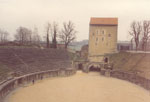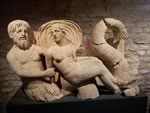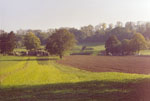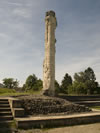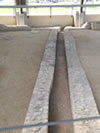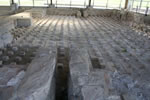 Archeoplus
Archeoplus
Avenches (VD)
Nowadays, Avenches is a town with 3000 inhabitants, but during the Roman period, about 20000 inhabitants lived there. She was the capital city of Helvetia and had the status of colony since the reign of the emperor Vespasianus. The decadence of thecity began during the second half of the 3rd century and it was a cathedral town up to the 6th century.
The main visible Roman monuments are the amphitheatre, the theatre, the sanctuary of the "Cigognier", the temple of the "Grange-des-Dîmes", the palace of "derrière-la-Tour", the forum baths, and the city wall. The city was supplied in water with several aqueducts. A section of one of them is still visible in Montagny (FR).
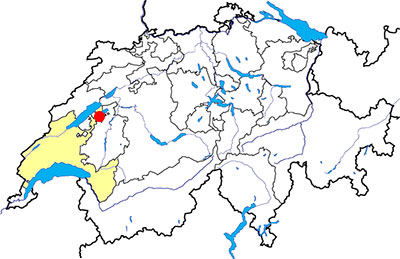
Canton: Vaud
Swiss topographic coordinates: 569'669, 192'188
Google Earth file: Avenches-en.kmz
Old names:
- Aventicum
- Forum Tiberii
- Colonia Pia Flavia Constans Emerita Helvetiorum Foederata
Documentation
Bibliography
- Bögli Hans, Aventicum, The Roman City and the Museum, Avenches, GAS 24, 1989
- Cardinaux Stéphane, Géométries sacrées, 2004, pp.234-237
- Cardinaux Stéphane, Géométries sacrées, tome 2, 2006, pp. 46-47, 60-63, 179
- Castella Daniel, Blanc Pierre, Flück Matthias, Hufschmid Thomas, Meylan Krause Marie-France, Aventicum, A Roman Capital City, Avenches, Association Pro Aventico, 2015, 128 p.
- Hochuli-Gysel A. (dir.), Avenches, capitale des Helvètes, AS 24, 2001.2, pp. 1-96.
- Le livre à remonter le temps (see Bibliography), pp. 25-27
Links
- Roman Museum of Avenches: http://www.aventicum.org
- Association Pro Aventico: http://www.aventicum.org/index.php/fr/association-pro-aventico
Others visible sites in the area
- Bas-Vully (FR): Celtic oppidum
- Gletterens (FR): Lakeside village
- Montagny (FR): Roman aqueduct, medieval castle
- Payerne (VD): Romanesque abbey church
- Vallon (FR): Roman villa (museum, mosaics), medieval church
The amphitheatre
Swiss topographic coordinates: 569'814, 192'293
The Roman museum
Swiss topographic coordinates: 569'857, 192'303
The theatre
Swiss topographic coordinates: 570'277, 192'203
The sanctuary of the "Cigognier"
Swiss topographic coordinates: 570'102, 192'368
The temple known as "de la Grange des Dîmes"
Swiss topographic coordinates: 569'997, 192'431
The palace of "Derrière-la-Tour"
Swiss topographic coordinates: 569'882, 192'603
The forum baths
Swiss topographic coordinates: 570'382, 192'881
The insula 23 building
Swiss topographic coordinates: 570'229, 192816
The city wall
Swiss topographic coordinates:
- East gate: 570'977, 193'023
- Tornallaz: 570'897, 193'131
- West gate: 569'629, 191'941
